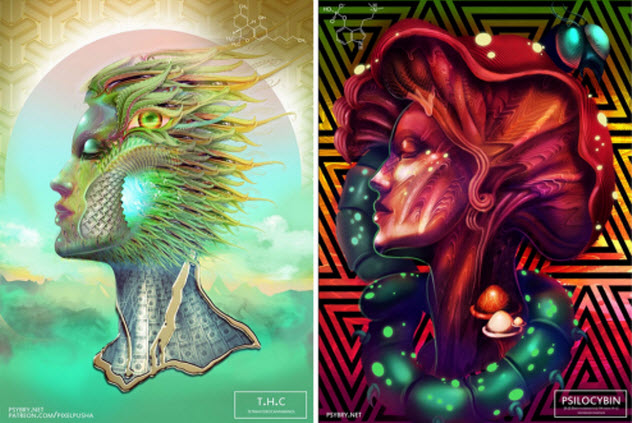 Politics
Politics  Politics
Politics  Weird Stuff
Weird Stuff 10 Eggs-traordinarily Odd Eggs
 History
History 10 Desperate Last Stands That Ended in Victory
 Animals
Animals Ten Times It Rained Animals (Yes, Animals)
 Mysteries
Mysteries 10 Devastating Missing Child Cases That Remain Unsolved
 Creepy
Creepy 10 Scary Tales from the Middle Ages That’ll Keep You up at Night
 Humans
Humans 10 One-of-a-kind People the World Said Goodbye to in July 2024
 Movies and TV
Movies and TV 10 Holiday Movies Released at Odd Times of the Year
 Politics
Politics 10 Countries Where Religion and Politics Are Inseparable
 Weird Stuff
Weird Stuff 10 Freaky Times When Famous Body Parts Were Stolen
 Politics
Politics The 10 Most Bizarre Presidential Elections in Human History
 Weird Stuff
Weird Stuff 10 Eggs-traordinarily Odd Eggs
 History
History 10 Desperate Last Stands That Ended in Victory
Who's Behind Listverse?

Jamie Frater
Head Editor
Jamie founded Listverse due to an insatiable desire to share fascinating, obscure, and bizarre facts. He has been a guest speaker on numerous national radio and television stations and is a five time published author.
More About Us Animals
Animals Ten Times It Rained Animals (Yes, Animals)
 Mysteries
Mysteries 10 Devastating Missing Child Cases That Remain Unsolved
 Creepy
Creepy 10 Scary Tales from the Middle Ages That’ll Keep You up at Night
 Humans
Humans 10 One-of-a-kind People the World Said Goodbye to in July 2024
 Movies and TV
Movies and TV 10 Holiday Movies Released at Odd Times of the Year
 Politics
Politics 10 Countries Where Religion and Politics Are Inseparable
 Weird Stuff
Weird Stuff 10 Freaky Times When Famous Body Parts Were Stolen
10 Fascinating And Trippy Works Of Art
Art is a way for people to express their thoughts, feelings, and emotions. For people who use drugs or have psychiatric disorders, their artwork may provide some insight into the unusual inner workings of their minds.
10 Brian Pollett

Brian Pollett is a 20-year-old graphic designer who also goes by the name Pixel-Pusha. As a project, he decided to go on a 20-day drug binge during which he created a new design each day.
Pollett said that he tested each drug to ensure its purity and then created artwork in his studio while listening to his favorite music. The drugs included alcohol, cocaine, and more.
Pollett put his finances and his reputation on the line for this project. He said that taking the psychedelic drugs truly changed him. He believes that he is “more open, honest, empathetic, forgiving, and courageous. I am perpetually in awe at the beauty surrounding us on a daily basis.”
The last “drug” that he used to influence his artwork was love. “For me, love is not limited to sex and romance,” he said. “Love is dedication to uplifting a person or idea to help them achieve their highest potential.”
Although he admits to taking most of the drugs, he did not take GHB, psilocybin, poppers, ether, 25i, or MDMA.
9 Edmund Monsiel

Edmund Monsiel was born and raised in Poland until the Nazi invasion forced him into hiding in his brother’s loft. He soon became a recluse. After the war ended, he remained hidden until his death in 1962.
Monsiel was known to suffer from both visual and auditory hallucinations as a result of his schizophrenia. At the time that his body was discovered, he was found to have drawn over 500 intricate pieces in lead pencil. His drawings—which mainly depict Christ or the Devil—suggest that he became extremely religious in his reclusive state.
Much of his artwork depicts a mixture of faces that are thought to represent his inner struggles. He transcribed visual hallucinations that he had of God and the Devil in 1943.
Despite living in a basic loft, his drawings are full of life and patterns. He drew faces in a wide range of sizes and shapes, with some drawings containing up to 3,000 faces.
8 Anonymous LSD

A reddit user known as whatafinethrowaway said she decided to do an artistic experiment with her friend using LSD. This experiment consisted of having her friend ingest 200 micrograms of LSD and then draw self-portraits over nine hours to illustrate the effects on her brain.
After ingesting the LSD, her friend sat down to draw the pictures, each of which took 15–45 minutes to complete. The pictures became increasingly abstract. About 45 minutes into the experiment, there is a noticeable change in her use of colors even though the artist claimed that she did not feel any different.
At one point, the artist suddenly stopped drawing eyes because she “didn’t feel like drawing them” and she didn’t want them “looking at her.” After four hours and 45 minutes, the artist stated, “I’m violet.” Then she drew her self-portrait in a shade of purple. This switched to flames in her next series of drawings.
The artist began to draw more of her body, which soon looked like a bunch of arbitrary lines. By nine hours and 30 minutes, whatafinethrowaway asked her friend to draw a normal picture. It is clear that the artist is coming off her high, but the picture still differs strongly from her original drawing.
7 Arthur Ellis

When most people imagine what it’s like to be blind, they picture darkness. But many times, this is far from the case. A 66-year-old painter named Arthur Ellis continues to paint everything he sees despite the fact that he lost his vision to meningitis at age 59.
Suffering from a disorder known as Charles Bonnet syndrome, Ellis experiences extremely vivid visual hallucinations rather than darkness. This syndrome is commonly acquired by those suffering from dementia, Parkinson’s disease, or macular degeneration.
One day, Ellis had a horrible earache, which was caused by bacterial meningitis. Soon, he was put on life support at the hospital. His family was told that he probably wouldn’t recover, but Ellis proved the doctors wrong.
When he awoke, he was horrified to find himself on the edge of a gigantic cliff. Told that he was blind, Ellis realized that his visions were not real. But they were terrifying nonetheless.
At first, Ellis had his sons move him to different rooms to try to escape the visions. Around the time that he was formally diagnosed with Charles Bonnet syndrome, Ellis began to cope with the visions. There is not much known about the disorder, but it believed that the brain tries to fill in the darkness from blindness with images from the patient’s past.
Ellis has resumed his old hobby of painting to try to make sense of these images. He knows that his mind is simply playing tricks on him, but he enjoys letting others take a peek at what he sees. Since he cannot see what he is drawing, Ellis relies on outsiders to tell him what they think of his paintings.
6 Oscar Janigar Experiment

Oscar Janigar was an experimental psychiatrist at the University of California who was known for tripping out. He did heavy research on LSD from 1954 to 1962 and was the man who introduced the drug to many celebrities.
Despite his support for the drug, he was only known to have done LSD about 13 times before it became illegal. He was extremely interested in how the drug could be used to open a person’s mind and increase their creativity.
In one of his experiments, he had 900 people take 200 micrograms of the drug, and then he recorded their experiences. During this time, he had 100 of these patients paint pictures.
When analyzed, these paintings tended to be brighter in color and more abstract than normal. A series of drawings done by someone on LSD is compiled above. The artist was asked to record what he was feeling while drawing each picture.
The drawings began as realistic depictions using charcoal, but they soon became almost unrecognizable. The artist continually commented that keeping control of the drawing implement was difficult.
It is clear that the mood of the patient went from unremarkable to euphoric and back to unremarkable. The experiment ends with the patient stating, “I have nothing to say about this last drawing. It is bad and uninteresting. I want to go home now.”
5 David Feingold

When he was young, David Feingold was struck in a hit-and-run accident that left him with a traumatic brain injury. Later in life, he developed bipolar disorder, temporal lobe epilepsy, and other cognitive difficulties from this brain injury.
Despite these impairments, Feingold found solace in artwork. As he explained in an interview on healing-power-of-art.org:
I have bipolar disorder. I am callously feared, avoided, judged, and marginalized even by family and friends who find it hard to engage with me because of my spoiled, bipolar reputation. My artwork reflects my feelings of helplessness, despair, and anger, stemming from both fearing and being feared by others.
He initially turned to art when he accidentally revealed his disorder during a manic phase. Feingold’s bipolar disorder is now well controlled by medication and the support of his loved ones, but he continues to struggle with the daily stigma.
In addition, he has become an advocate for other artists with cognitive and psychological impairments. Some may find his artwork disturbing, but Feingold uses it to give others a look into his mind.
Many times, it is difficult to understand what those with psychiatric disorders experience. Feingold makes an attempt to share his thoughts, frustrations, anger, and sadness with the people who see his artwork. He hopes that his artwork will decrease the stigma surrounding those with bipolar disorder as well as help those with the disorder to better understand their struggles.
4 Karen May Sorensen

Karen May Sorensen is an artist who has dealt with schizoaffective disorder for 20 years. Early on, she seemed to be overwhelmed by activities like holding a job and going to school. From a young age, she wanted to become a writer but noticed that she could only write in 90-minute increments.
At age 19, her mental abilities began to change drastically. She became more reclusive and stared off into space for minutes at a time. Soon, she was committed to a mental hospital. She stayed there for two years before being diagnosed with schizoaffective disorder.
Sorensen is a self-taught artist and keeps a blog where she posts her daily paintings along with her thoughts and feelings about them. Although she believes that her brain is normally low functioning due to her disorder, she is high functioning when it comes to art.
Art has helped her to cope with the stresses and struggles in her life. It has given her a way to express how she feels inside. Many people with psychiatric disorders must go through the experimental phase of finding the correct medication and dosage to treat their symptoms.
Sorensen’s paintings allow us to see her progress as her medication changes. Certain paintings are quite calm in appearance while others relieve her disorder a bit more.
In her blog, she occasionally compares her artwork to that of her brother, who does not suffer from schizoaffective disorder. Her artwork exemplifies her evolution through the process of her disorder.
She also provides comments on her paintings to let us understand what goes on in her mind. It is fascinating to view the changes in her artwork with each medium, medication, and mood.
3 Missy Douglas

Many people keep a diary to record their daily thoughts, but Missy Douglas decided to paint pictures instead. Every day for one year, Missy painted a picture that expressed her daily thoughts and feelings.
This 37-year-old artist, who suffers from bipolar disorder, decided to stop taking her medication for one year to bare her mind on canvas. After being diagnosed at age 19, she finally understood why she experienced extremely high highs and extremely low lows. She began the project after keeping her diagnosis a secret for 17 years.
Soon, she realized how cathartic the project was for her and decided to share it with others in her book 2:365. She hopes that it will show others with bipolar disorder that they are not alone in their feelings. She also hopes that the project will decrease the stigma surrounding mental illness.
Missy wants to give viewers a look into the daily mind of a woman suffering from bipolar disorder. Her paintings are abstract, but the theme of each painting can be seen and felt through the shapes, textures, and colors that she used.
2 Louis Wain

Louis Wain was an English artist who is most well-known for his drawings of anthropomorphic cats. His first cat was drawn in 1886 and published in Illustrated London News in a picture known as A Kitten’s Christmas Party.
As the years went on, his cats grew more human with more exaggerated features. Wain was a prolific artist who would frequently draw over 100 cat pictures a year. His work was featured in many different magazines and on various postcards.
Soon, Wain began showing the signs of schizophrenia. It is speculated that the onset of his disorder was caused by the Toxoplasma gondii parasite that lives in cat feces. In 1924, he was committed to Springfield Mental Hospital where he continued his hobby of drawing cats.
As his disorder progressed, his drawings changed drastically. The cats became more abstract and experimental. His most famous work consisted of a series of eight paintings that showed his “deterioration.”
Some believe that his change in style was due to Asperger’s syndrome rather than schizophrenia. Instead of diminishing his abilities as an artist, his mental illness seemed to intensify them. He began experimenting with brighter colors, more intricate details, and more abstract designs. However, it is unknown if his famous series of paintings is in the correct order as Wain did not date his artwork.
1 Brian Lewis Saunders

Much like Brian Pollett, Brian Lewis Saunders decided to experiment with more than just drugs. He was known mainly as a performance artist from Tennessee until he drew self-portraits on various drugs.
In 1995, Saunders decided to draw a self-portrait every day. As of early 2016, he has over 8,700 sketches. But for 50 days in a row, he created his self-portrait under the influence of a different drug each day.
He obtained these drugs from various doctors, druggies, neighbors, and friends. He also got some of the drugs during his stay at a mental hospital. According to Saunders, all the drugs were free.
He has drawn himself on everything from cocaine to the exceptionally terrifying bath salts. If there ever was a good reason to stay away from drugs, these self-portraits definitely illustrate it.
Saunders claims that he became lethargic and soon suffered from mild brain damage. But he wanted to see how the drugs changed his self-perception. It’s unclear how he stayed motivated enough to complete his drawings while on these drugs.
+ Spiders On Drugs

It’s not a surprise that NASA gets to work on cool stuff. At one point during their studies of outer space, they turned their attention to spiders. They were attempting to see if the common house spider could be used to test the toxicity of drugs based on their webs.
To do this, the scientists got a group of spiders really stoned on various substances. According to their records, the spiders on marijuana made a good attempt at spinning their webs. But they seemed to give up about halfway through and left a hole in their webs.
On sleeping pills, the spiders wouldn’t spin their webs. Spiders on speed seemed to enthusiastically spin their webs but did not plan it out and created different holes. The effects of these drugs on web spinning seemed to be remarkably similar to what occurs with people who take drugs.
Shelby is an undergraduate at Arizona State University studying psychology and biochemistry. She is constantly fascinated by the mysteries of the world around her. Next year, she will be going on to medical school to continue studying and discovering the medical mysteries around her.








